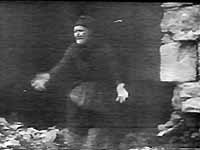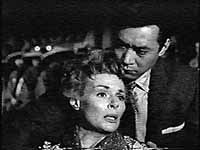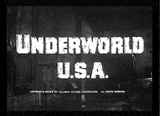At the discourse level, Fuller creates a series of expository essays to both describe a social problem and argue for change.
Fuller's texts occasionally shift from the dominant narrative mode (the focal point of characters within the story plane) to a different discursive formation, one unmotivated by character, just exposition. Exposition, according to Chatman, combines both the descriptive and argumentative modes. It is descriptive because it abstractly defines a social problem; it is argumentative because it indirectly requests that the audience do something about the problem.
 Verboten! (1958). A C.O. tells James Best: "Seems they found Hitler dead with a piece of silver paper in his fist on which he had written, 'I was never a nazi.'" A shock edit follows with a series of stills and documentary images unmotivated by character, featuring hollowed out German planes, aerial footage of a city in ruin, a woman screaming and gesticulating with her arms. Refugees walk streets; the Red Cross hands out food. This collision is a mini-essay which comments on what Hitler's nazism has wrought the world.
Verboten! (1958). A C.O. tells James Best: "Seems they found Hitler dead with a piece of silver paper in his fist on which he had written, 'I was never a nazi.'" A shock edit follows with a series of stills and documentary images unmotivated by character, featuring hollowed out German planes, aerial footage of a city in ruin, a woman screaming and gesticulating with her arms. Refugees walk streets; the Red Cross hands out food. This collision is a mini-essay which comments on what Hitler's nazism has wrought the world.
 Crimson Kimono (1959). Pure Fullerian description, a mini-essay. Long-shot of Evergreen Cemetery in Los Angeles. Cut to a white column with a Nisei soldier on it. Cut to a huge stone and an Eisenhower quote that salutes "the men who gave for their country." Cut to another huge stone and a quote by Mark W. Clark, General, USA: "The soldiers who lie here symbolize the fealty and courage of Nisei troops . . . may they rest in honored peace." Cut back to long shot of the white column. This sequence both separates Nisei soldiers (they have their own monument) and links them (through the words of white generals) to the mainstream. This is the larger theme in the film (Kojaku's liminality and his troubled relationship with Charlie). The ending of Crimson Kimono is also descriptive. James Shigeta (Detective Joe Kojaku) guns down the female killer and her story mirrors his own: "It was all in my mind." As she collapses in his arms, Fuller's camera cuts to a series of Asian faces, who look on as the detective holds the dying woman. These cut-ins aren't achieved through eye-line matches and are thus unmotivated by character. Instead, these close-ups function as descriptive commentary that punctuate a theme: Shigeta's fear of his own skin, his own people and their collective gaze at his guilt.
Crimson Kimono (1959). Pure Fullerian description, a mini-essay. Long-shot of Evergreen Cemetery in Los Angeles. Cut to a white column with a Nisei soldier on it. Cut to a huge stone and an Eisenhower quote that salutes "the men who gave for their country." Cut to another huge stone and a quote by Mark W. Clark, General, USA: "The soldiers who lie here symbolize the fealty and courage of Nisei troops . . . may they rest in honored peace." Cut back to long shot of the white column. This sequence both separates Nisei soldiers (they have their own monument) and links them (through the words of white generals) to the mainstream. This is the larger theme in the film (Kojaku's liminality and his troubled relationship with Charlie). The ending of Crimson Kimono is also descriptive. James Shigeta (Detective Joe Kojaku) guns down the female killer and her story mirrors his own: "It was all in my mind." As she collapses in his arms, Fuller's camera cuts to a series of Asian faces, who look on as the detective holds the dying woman. These cut-ins aren't achieved through eye-line matches and are thus unmotivated by character. Instead, these close-ups function as descriptive commentary that punctuate a theme: Shigeta's fear of his own skin, his own people and their collective gaze at his guilt.
 Underworld USA (1961). Fuller expands on the descriptive pause with three frozen images: Mencken's daughter lies dead on the street, discarded shoes and a mangled bicycle next to her; corrupt chief Fowler kills himself and the exit bullet lodges in a portrait of the police force; Tolly lies dead in a back alley and as the camera tracks in on his clenched fist it transforms into a grainy newspaper still. All three images circumscribe the action and invite a viewer to ascribe meaning, to "write a caption." These images halt story time and ask that we consider them separate from story, as parts of the text's larger discursive statements on crime: the dead girl is a victim of immoral gangsters; the lodged bullet suggests corruption within police departments across the country; Tolly's cinema fist represents the drive and failure many experience in their fight out of the gutter.
Underworld USA (1961). Fuller expands on the descriptive pause with three frozen images: Mencken's daughter lies dead on the street, discarded shoes and a mangled bicycle next to her; corrupt chief Fowler kills himself and the exit bullet lodges in a portrait of the police force; Tolly lies dead in a back alley and as the camera tracks in on his clenched fist it transforms into a grainy newspaper still. All three images circumscribe the action and invite a viewer to ascribe meaning, to "write a caption." These images halt story time and ask that we consider them separate from story, as parts of the text's larger discursive statements on crime: the dead girl is a victim of immoral gangsters; the lodged bullet suggests corruption within police departments across the country; Tolly's cinema fist represents the drive and failure many experience in their fight out of the gutter.
 Naked Kiss (1964). The opening sequence implicates the spectator and opens the text up to its social context. Fuller attached the camera to the pimp, and when prostitute Constance Towers (Kelly) belts him, a wonderful gutter poetry is created as the camera shakes. The jarring immediacy of the camera elides spectator with pimp and places us and an exploitive, male-dominated society under direct attack.
Naked Kiss (1964). The opening sequence implicates the spectator and opens the text up to its social context. Fuller attached the camera to the pimp, and when prostitute Constance Towers (Kelly) belts him, a wonderful gutter poetry is created as the camera shakes. The jarring immediacy of the camera elides spectator with pimp and places us and an exploitive, male-dominated society under direct attack.




















